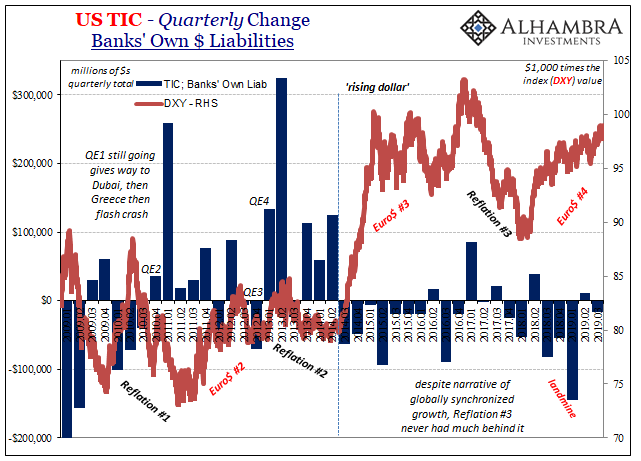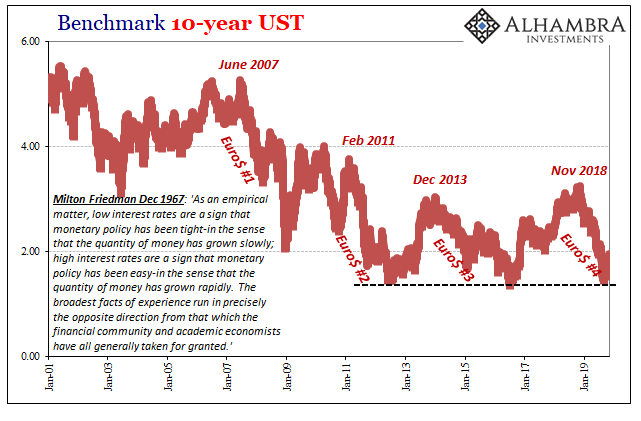I don’t think that was quite the message the FOMC wanted to send. It’s pretty clear what the Committee wanted to say, or wanted everyone to hear. The members are done with rate cuts because everything looks great. Sure, it all looked great to them last year but, as has become the conventional interpretation of late, hey, at least it didn’t get worse. That’s where we are in this “cycle”, cheered up presumably by the lack of fulfilled downside.
However, despite the apparent emphasis on three-and-done and the relatively stable or positive economic scenario under which that would be appropriate, it is elsewhere in the committee’s recently released minutes that is getting most attention. For the October 29-30 meeting, the published work is more convincing when it discusses the “downside risk” numerous times.
One example:
However, other downside risks had not diminished. In particular, some further signs of a global slowdown in economic growth emerged; weakening in the global economy could further restrain the domestic economy, and the risk that the weakness in domestic business spending, manufacturing, and exports could give rise to slower hiring and weigh on household spending remained prominent.
Perhaps the most concerning (because it was the most honest, and actually consistent with how the economy has developed over the last year or so):
Moreover, the staff still judged that the risks to the forecast for real GDP growth were tilted to the downside, with a corresponding skew to the upside for the unemployment rate. Important factors in that assessment were that international trade tensions and foreign economic developments seemed more likely to move in directions that could have significant negative effects on the U.S. economy than to resolve more favorably than assumed. In addition, softness in business investment and manufacturing so far this year was seen as pointing to the possibility of a more substantial slowing in economic growth than the staff projected. [emphasis added]
That part especially resonates because the economy always evolves more slowly than the staff ever projects. What comes out of these specific minutes when you read them as a whole is how three-and-done appears more to be the FOMC’s unsubstantiated hopes than solid, honest analysis. They want it to be a solid economy, but the text then repeatedly lists all the very convincing ways it might not be.
Perhaps the most compelling of these is what had been discussed about the labor market. It is interesting to note that the minutes mention officials admitting to 2019 being much slower growth-wise in employment than 2018 while incorporating the BLS’s yet-to-be-dropped-hammer benchmark revisions.
However, the pace of job gains so far this year was slower than last year, even after accounting for the anticipated effects of the Bureau of Labor Statistics’ benchmark revision to payroll employment, which will be incorporated in the published data in February 2020.
I’m sorry, that’s a pretty bad sign as far as the labor data, and therefore economic reality, is concerned. What the staff economists likely told policymakers was that the BLS went back and checked state unemployment payments (which have to be made for every payroll) and has already figured that one-fifth of job gains previously thought to have materialized between March 2018 and March 2019 never did. They never happened.


Therefore, what the minutes are suggesting is that even accounting for that huge downgrade between last March and this past one, the labor market throughout all of 2019 will be even slower! With revisions, 2018 doesn’t look all that good, not nearly as strong as they kept claiming.
Now, on top of that, 2019 appears almost certain to come out substantially weaker still.
Remember, it is the labor market that is supposedly the economy’s underlying strength, the very positive force that will work with the three rate cuts to keep everything largely on track. If the labor market wasn’t all that good last year and is going to underperform this year…
Now you understand why three-and-done isn’t so solid even to these empty suits, overwhelmed in the text by “downside risk.”
Separately, in the official mind, anyway, in reality not so much, there were substantial discussions about the repo market. Of course there is ongoing repo deliberation. It makes sense that there would have been given that officials still have no idea what happened or why. That much, too, the minutes make plain.
September’s repo rumble pretty much destroyed Jay Powell’s carefully laid plans of a quiet and reassuring “mid-cycle adjustment.” It was near impossible to say nothing-to-see-here when, in fact, everyone could see how there was something unexpected and substantial taking place right in the Fed’s very own backyard – fed funds.
Having been thoroughly embarrassed and roundly criticized by even its most fervent supporters, the staff has been hard at work running statistical simulations about how the market might behave, in regression analysis, should the Fed opt for a combined approach of “ample” reserves (the not-QE small-scale asset purchase) plus some form of ongoing repo operations (which, as I keep pointing out, don’t directly involve the repo market, merely some of the repo players in that market).
There was conjecture about ongoing perhaps permanent overnight and term repo operations versus a standing repo facility; usually along the same lines as anything else the Fed does. Policymakers are worried about stigma, funding risky behavior, moral hazard, etc. None of that actually matters when the minutes spell out what actually does; the one thing authorities, apparently, still cannot answer for:
The manager pro tem noted that diminished willingness of some dealers to intermediate across money markets ahead of the year-end could result in upward pressure on short-term money market rates. Forward measures of market pricing continued to indicate expectations for such pressures around the year-end. [emphasis added]
Two months later and they still don’t know (as to the highlight portion). That’s ultimately what the FOMC was discussing at the October meeting; we have no idea why dealers refused to get involved in the repo market in September, therefore we are going to do a bunch of stuff in the unsupported hope maybe through nothing more than random good fortune some of it helps next time around.
Throw a bunch of sh** at the wall and hope something sticks so that the next rate cut (which the FOMC wants you to know it is not “expecting” to happen) won’t be similarly overshadowed by the same unknown problems in repo. Especially because next time could be a real thing (as opposed to September’s dress rehearsal):
Many participants remarked, however, that even in an environment with ample reserves, a standing facility could serve as a useful backstop to support control of the federal funds rate in the event of outsized shocks to the system. [emphasis added]
That’s because, again, reserves don’t actually matter for effective monetary elasticity, repo or otherwise.
Nowhere was it discussed, or at least reported in the minutes, as to the ridiculous flaw in the design (because this is all window dressing). If there is going to be “diminished willingness of some dealers to intermediate across money markets” again in the future, what good will it do for those overall money markets when the Fed opens up more reserves to those same increasingly unwilling dealers?
Dealers already possess excess reserves, so is the FOMC shooting for some other relevant functional level above that; excess excess reserves? These dealers don’t want to lend in money markets, so they don’t, which causes the Fed to get involved by giving the same dealers more of what they don’t want to lend in money markets.
Brilliant!
Like three-and-done, the repo plan is more hope than the product of solid understanding. Ben Bernanke in 2012 said the Fed needed to be more transparent. I don’t believe this is quite what he had in mind.
But to the financial media, something something more money printing. As I wrote yesterday, it’s not printing just more rising dollar stuff.



Stay In Touch